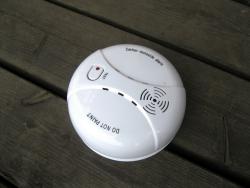Carbon Monoxide Alarm Systems
Carbon monoxide detectors are crucial in the fight against monoxide poisoning and its potentially fatal effects. If you want to learn how carbon monoxide alarm systems work, where to install one, and how to maintain such a device, read on.
One of the main issues with monoxide carbon is the fact that it is a gas that is invisible to the human eye, and it cannot be smelled or tasted, which makes it a quiet killer. In order to make sure your family, employees, patients, or guests are properly safeguarded from it, you need to rely on carbon monoxide alarms.
Why Is Inhaling Carbon Monoxide Dangerous?
As stated earlier, carbon monoxide or CO in short is an odorless and colorless gas that has no taste and which is potentially poisonous to humans. Since the gas cannot be acknowledged in a room, it becomes incredibly dangerous and sometimes deadly, when inhaled for relatively long periods of time.
The gas is generated when materials that contain carbon are not completely combusted. Six out of ten Americans are unable to identify the signs of a carbon monoxide leak in their homes home. CO poisoning is, in fact, the second most common cause of death by poisoning that is not caused by the use of medicines, with more than 10,000 people seeking medical attention treatment on a yearly basis, and over 400 deaths from poisoning, according to data from the CDC. The severity of CO exposure depends on the amount of CO found in a room and their direct exposure to it. Even smaller concentrations of CO can wreak havoc on one's health and well-being in time, over expanded periods of time.
How Can A Carbon Monoxide Detector Help?
For starters, these detector safety devices that will do a great job at alerting you of a carbon monoxide leak and help you escape a potentially life-endangering scenario. CO poisoning is responsible for a significant number of accidental deaths in the US and having a reliable carbon monoxide alarm system to protect you against this silent enemy is a must. When installed and maintained properly, a good carbon monoxide alarm will effectively detect the gas and alert you. In case of a CO leak, you will need to immediately reach a source of fresh and clean and the sooner you will manage to do that, the better your odds of escaping the consequences. A CO detector will offer you and the rest of the members of your household a warning in advance so you quickly leave your home during the emergency scenario.
What Causes CO Leaks
CO is produced by home devices that use fuel to burn, such as dryer vents, furnaces, chimneys or fireplaces. This is why it is crucial to have all of them checked for malfunctions and faults periodically and with the help of professional services.
Installation Spots For Carbon Monoxide Alarms
These CO detectors should be installed on all levels of your household so they can ensure the protection of all family members. Everyone should be able to hear the detectors sounding the alarm letting them know there is a gas leak they need to escape. It is also advised to install carbon monoxide alarms in all sleeping areas, as well as the living room and any other common rooms for enhanced protection. Carbon monoxide alarms can be installed on every wall or on any ceiling in a room without risking to affect their efficiency in any way.
Testing And Replacement Of Carbon Monoxide Alarms
CO detectors should be inspected periodically and tested for faulty mechanisms, at least once every 30 days. For models that work with batteries that need to be replaced, you should make a habit out of replacing the batteries twice a year. Keep in mind that simply replacing drained batteries will not suffice, as these detectors are not built to last for an entire lifetime and they will eventually break, usually after 5-7 years. Carefully read the lifetime specified on the box the detector came in for exact details.
Why Do Carbon Monoxide Alarms Beep?
Carbon monoxide alarms feature various beeping patterns used to communicate the fact that the device has detected a gas leak or whether the batteries or device require replacement. Knowing how to interpret these beeps is, therefore, important.
-
Hearing four beeps followed by a pause would translate to the presence of CO in the air. If this is the case, immediately go somewhere where you can find a fresh source of air and call 911.
-
Hearing a single beep every 60 seconds every means that your CO detector's batteries are low and they require replacement.
-
Hearing five beeps every minute means the detector has broken down or reached the end of its lifespan and you will need to buy and install a replacement.
Carbon monoxide alarm systems are meant to periodically and repeatedly verify the levels of Co in the air and proceed to sound the alarm prior to the air reaching potentially harmful levels of the gas. This way, these alarms can effectively prevent the accumulation of CO in the environment and let household members or employees, and people in commercial facilities reach safe places with proper air ventilation. There are CO detectors that can send instant alerts to specialized monitoring services which will, in turn, send over their emergency crews if needed.
Legal Requirements For Installing CO Detectors
Starting with March 2018, most U.S. states have issued and enacted their own statutes in regards to the installation of carbon monoxide alarms, with other states having promulgated their own rules regarding CO alarms. For example, the state of Alaska asks these devices to be approved by the state fire marshal in order to be installed in all households. States like Connecticut, Vermont, Oregon, Rhode Island, and others require fitting CO detectors in all new constructions, while people who live in Florida must install them in all rooms that contain a boiler. The people of Minnesota are required to carry CO detectors in their motorboats.
